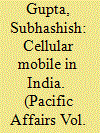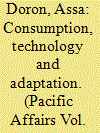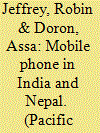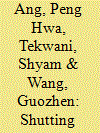|
|
|
Sort Order |
|
|
|
Items / Page
|
|
|
|
|
|
|
| Srl | Item |
| 1 |
ID:
113964


|
|
|
|
|
| Publication |
2012.
|
| Summary/Abstract |
Telecommunications has been one of the success stories of economic reforms in India. From a teledensity of 2 percent in the not too distant past the sector has grown to a point where the teledensity exceeds 60 percent. The Indian cellular market is marked by strong competition, a large number of operators and some of the cheapest tariffs in the world. The sector experiences growth rates in excess of 80 percent in terms of the number of subscribers. However, all is not well in this sector. There have been a number of upheavals in the past and the latest one involves alleged favouritism in allocating spectrum.
This paper analyzes the state of competition in the cellular mobile industry in India. Standard measures of competition such as HHI and concentration ratios are used as well as market share, revenues, access to funds and profits. We also look at the degree of rivalry in the industry through changes in rankings in market share. We provide a brief discussion of the major developments in telecommunications and cellular mobile in particular after the introduction of reforms. Effects of policy making by different institutions within India are discussed in relation to their effect on competition and market development.
|
|
|
|
|
|
|
|
|
|
|
|
|
|
|
|
| 2 |
ID:
113968


|
|
|
|
|
| Publication |
2012.
|
| Summary/Abstract |
On the edges of the digital world in India, there are millions of mobile phone users. To cater for these consumers, an economy of mobile phone care and repair has emerged in almost every town. Through the experiences of consumers and repairers, this article explores technology distribution, service practices and economic opportunity. How do they learn their trade? How do they make a living? And how do they position themselves in relation to the official branded manufacturers and licensed agents? Conceptually, the article is concerned with the nexus between consumer culture, the Indian middle class and the poor and how they engage global capitalism. It argues that middle-class ideologies and practices of consumption are both exclusive and expansive. At the same time, the poor seek to engage this economy by tapping into the unauthorized sector that responds to their demands for local participation in the global economy, while keeping them also at a certain distance from the forms and symbolic capital of the new economy.
|
|
|
|
|
|
|
|
|
|
|
|
|
|
|
|
| 3 |
ID:
113966


|
|
|
|
|
| Publication |
2012.
|
| Summary/Abstract |
The explosive growth in India's mobile telephony during the last decade coincided with a robust growth in its trade with China. A variety of imported equipment from China played a critical role in augmenting the use of mobile phones and expansion of networks in India. This paper studies the trends of these imports and examines the reasons for their penetrating deep into the Indian market. It argues that Chinese imports bridged a serious supply-side deficiency in India's telecom sector: the absence of a modern indigenous equipment manufacturing industry. Pointing out that development of the latter has been stunted due to low R&D, limited innovations, lack of access to finance, and liberal access to imports, the paper argues that Chinese imports are likely to continue until these conditions prevail, notwithstanding security concerns over such imports.
|
|
|
|
|
|
|
|
|
|
|
|
|
|
|
|
| 4 |
ID:
113965


|
|
|
|
|
| Publication |
2012.
|
| Summary/Abstract |
India has one of the fastest growing and largest telecommunications services markets in the world. To begin with, most of the increases in telecom services were met through imports. The state has now responded to this situation by attempting to make India a manufacturing hub for telecommunications equipment. Although there is evidence of increased domestic production, the surging demand has necessitated imports. The value added by domestic manufacturing is still very low, but is likely to increase as the scale of domestic manufacturing increases.
|
|
|
|
|
|
|
|
|
|
|
|
|
|
|
|
| 5 |
ID:
113963


|
|
|
|
|
| Publication |
2012.
|
| Summary/Abstract |
This article scans the effects of mobile-phone communication, particularly in South Asia. It focuses on three important areas: political economy, politics and social practices. By 2012 India had more than 900 million telephone subscribers, 96 percent of them on cell phones, and the majority of users were the poor. At the other end of the social scale, the mobile phone provoked bitter struggles among some of India's biggest business houses and branches of government, and was responsible for criminal cases against politicians at the highest level.
The essays in this volume are a reminder that technology is anything but neutral. The essays examine the many facets of mobile phone communication and the institutions, agents, mechanisms and networks such communication relies on. The essays contribute to efforts to interpret the effects of this technology and to gain insight into the most important aspect of the mobile phone: the sheer variety of activity (political, social and cultural) on which it impinges.
|
|
|
|
|
|
|
|
|
|
|
|
|
|
|
|
| 6 |
ID:
113969


|
|
|
|
|
| Publication |
2012.
|
| Summary/Abstract |
The paper analyzes SMSGupShup, a mobile-centric social networking platform in India. It focuses on a set of dominant users (young, male) who are redefining the nature of micro-blogging and the creation of mobile networking communities. Like many social networking sites, assembling, maintaining and growing social networks are primary behaviours on GupShup. Unlike many others, where maintaining a personalized profile and conversing with a networked community take prominence, users of GupShup show markedly different messaging or broadcasting practices. While captivated by the idea of connecting with people all over India for the first time through the GupShup platform, the primary motivation of users is not conversation, forging a "second life" or building interest groups, but optimizing the networking service to expand one's own group membership. From a qualitative study of user profiles, the paper demonstrates how GupShup can inform thinking about facets of mobile communities in developing countries: specifically, changing ideas about the networking platform as a "second social life" to one of a pecuniary "resource."
|
|
|
|
|
|
|
|
|
|
|
|
|
|
|
|
| 7 |
ID:
113967


|
|
|
|
|
| Publication |
2012.
|
| Summary/Abstract |
On 1 February 2005, the Kingdom of Nepal cut off all public telecommunication links to the outside world. According to the king, the shutdown in communications was to enable security operations against the Maoist insurgents. Landline and Internet services were restored gradually over the following weeks. But the pre-paid mobile phone service, which was used by the majority of Nepalese, stayed off for the public for 88 days. The shutdown in communications provided the environment for a natural experiment to look at the impact of the mobile phone. Researchers conducted interviews in three regions of Nepal that are taken by the Nepalese as representative of the country. Among those interviewed were politicians, including the then-prime minister, business owners, journalists, as well as military and police officers. The study found that the shutdown in mobile communications had limited success in helping security operations. The insurgents did not trust the mobile phone network and had developed their own parallel communication network. The larger impact was negative: it hurt the economy and alienated large swathes of the public, perhaps even contributing to the downfall of the king. The study suggests that the mobile phone is a social device and that if there is to be any shutdown of the mobile phone service, it should be done only briefly and for very clear security reasons.
|
|
|
|
|
|
|
|
|
|
|
|
|
|
|
|
|
|
|
|
|